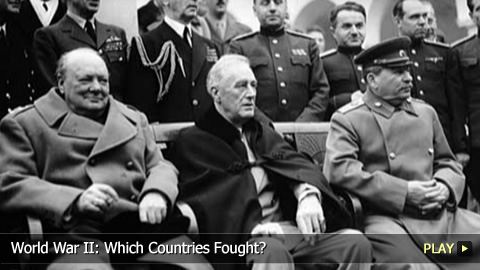World War II: Which Countries Fought?

Rise of the Nazi Party
Even as World War I ended, the seeds for the second great global battle had been sown. 1919’s controversial Treaty of Versailles placed all the blame for the First World War squarely on the shoulders of the Germans, and this was a tool the rising Nazi party used to build support for their cause.
Allies vs. Axis
The Second World War was basically a battle between the Axis Powers and the Allies. The grouping of countries that comprised the Axis alliance was considered the main antagonists in the fight, and consisted mainly of Adolf Hitler’s Nazi Germany, Benito Mussolini’s Kingdom of Italy and Hirohito’s Imperial Japan.
Expansionism and the Tripartite Act
These three countries were drawn together by their similar expansionist interests and discontent at the results of World War I. By 1940, the relationships and goals of these countries were solidified by treaties and military alliances. By creating the Tripartite Act of 1940, Germany’s Third Reich became the informal leader of the Axis.
Other Axis Nations
Hungary was another Axis nation, and this country joined Germany in its war on the Soviet Union a few days after it began in June 1941. Romania started off in favor of the British, but eventually fought for the Axis. Bulgaria was another German ally, and a number of additional countries came and went from that side of the fight.
The Allies
The Allies countries were united by a concern that the Axis was trying to dominate the world. They were nations that had already been invaded or that were threatened with invasion.
The United Kingdom, France and Poland
Originally, Poland, the United Kingdom and France teamed up in the face of the Nazi menace on Poland, and in fact they were joined by existing pacts and alliances. However the Polish-British Common Defense Pact signed August 25th, 1939 ensured that the three countries would protect each other from Nazi attacks. It was the September 1st invasion of Poland by the Nazis that sparked the entire conflict and is widely considered the first day of World War II.
United States
The Allies were aided by the rest of the British Commonwealth nations like Canada, Australia, New Zealand and South Africa. Eventually the United States entered the fray after the December 1941 attack by Japanese troops on Pearl Harbor. U.S. president Franklin D. Roosevelt, UK Prime Minister Winston Churchill and Soviet Union leader Joseph Stalin came to be known as the “Big Three” leaders in the fight.
More Allied Forces
China was another important force on this side, and joined following an invasion by Japan in 1937. In addition, countries like Belgium, Brazil, Czechoslovakia, Ethiopia, Greece, India, Mexico, the Netherlands, Norway and Yugoslavia were Allies. These Allied nations helped form the basis of the United Nations when that organization was eventually founded in 1945.
Results of These Alliances
With these alliances in place, the Second World War came to involve over 100 million military recruits and most of the countries in the world. Like World War I, this battle drastically altered the geopolitical landscape. As a result, the Soviet Union expanded and grew more powerful, a communist movement took control in China and world power swung from Europe to the United States of America. The consequences of this war played out on the world stage throughout the twentieth century with the founding of the United Nations as an organization intent on keeping world peace.
